Although the silver jubilee celebrations of the Indira Gandhi National Open University (estb.1985) were dutifully inaugurated in Delhi on November 19 last year, there seems little awareness or pride in the unique achievements of the world’s largest distance education varsity. Autar Nehru & Summiya Yasmeen report
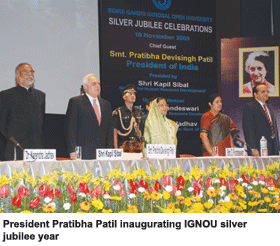 A historic silver jubilee anniversary — a landmark in the evolution of Indian education — is being ignored by Indian academia and the public. Outside the sprawling 150-acre Delhi campus and 60 regional centres countrywide of the Indira Gandhi National Open University (IGNOU), there seems little awareness or pride in the achievements of this unsung enterprise which has contributed 197,722 graduates, 194,196 postgrads, 309,225 vocational diploma holders and 407,298 certified professionals to the national talent pool and workforce.
A historic silver jubilee anniversary — a landmark in the evolution of Indian education — is being ignored by Indian academia and the public. Outside the sprawling 150-acre Delhi campus and 60 regional centres countrywide of the Indira Gandhi National Open University (IGNOU), there seems little awareness or pride in the achievements of this unsung enterprise which has contributed 197,722 graduates, 194,196 postgrads, 309,225 vocational diploma holders and 407,298 certified professionals to the national talent pool and workforce.
However in the national capital the silver jubilee celebrations of India’s pioneer distance education varsity, established in 1985 by a special Act of Parliament (IGNOU Act, 1985), were dutifully inaugurated on November 19 (‘Foundation Day’) last year by President Pratibha Patil, who commended the world’s largest distance education university with a massive enrolment of 2.89 million students for “reducing disparities in education by extending opportunities to villages and remote areas, and in generating a movement that will impel people to acquire knowledge and skills”. But typically, this landmark achievement of one of the country’s handful of institutions of higher education excel-lence attracted minimal media interest.
Yet there are reasons why the nation, particularly its aspirational middle and lower middle classes, should celebrate the contribution of this low-profile high-tech institution to the national develop-ment effort. For one, in a country where a mere 12 percent of youth in the age group 18-24 are enroled in higher education institutions (cf. 25 percent in China and over 60 percent in the US), over the past 25 years this path-breaking institution has provided over a million students access to higher education through its flexible open and distance learning (ODL) delivery model. Currently 15 percent (1.8 million) of the 12 million students enroled in India’s higher education system are enroled in IGNOU. Last year, it awarded degrees, diplomas and certification to 137,000 students countrywide, and on average 200,000 students sign up for IGNOU study programmes every year. In sharp contrast the country’s 15 IITs (Indian Institutes of Technology) and eight IIMs (Indian Institutes of Management) admit 8,300 and 3,000 students respectively per year.
Promoted by the Central government with an initial grant of Rs.2.93 crore to provide “higher education to large sections of the population and particularly disadvantaged segments of society”, over the past quarter century IGNOU has played a significant role in expanding the access of India’s educationally short-changed youth to higher education. From an initial offering of only two study programmes to 4,528 students in 1987, IGNOU has steadily expanded to lay claim to the status of the world’s largest open university offering 338 (including 16 vocational) progra-mmes through its 21 schools of study and 21 centres and institutes to 2.89 million students. This mammoth student population, set to cross the 3 million milestone this month (April), is tutored by a core faculty of 400 supported by a team of 36,000 academic counselors operating from 61 regional centres and 3,000 learners study centres.
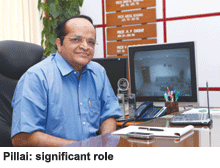 “IGNOU was promoted in 1985 to offer higher education opportunities to students from all sections of society, particularly the marginalised and disadvantaged living in rural areas. Twenty-five years on, IGNOU has remained true to its founders’ vision, and plays a significant role in demo-cratising higher education and providing access to millions of students who cannot enrol in formal higher education institutions. India’s conventional colleges and universities don’t have the capacity to cope with the scale of the higher education challenge confronting the country and distance education powered by new information communi-cation technologies (ICTs) has to be used to supplement conventional tertiary education. During the past 25 years IGNOU has demonstrated that quality higher education can be delivered through the flexible open distance learning (ODL) models, which we have greatly improved by harne-ssing the full power of ICTs. The Union government has identified IGNOU as an important partner in reaching the national goal of 15 percent enrol-ment in higher education by 2015,” says Dr. V.N. Rajasekharan Pillai, the mission-driven vice chancellor of IGNOU.
“IGNOU was promoted in 1985 to offer higher education opportunities to students from all sections of society, particularly the marginalised and disadvantaged living in rural areas. Twenty-five years on, IGNOU has remained true to its founders’ vision, and plays a significant role in demo-cratising higher education and providing access to millions of students who cannot enrol in formal higher education institutions. India’s conventional colleges and universities don’t have the capacity to cope with the scale of the higher education challenge confronting the country and distance education powered by new information communi-cation technologies (ICTs) has to be used to supplement conventional tertiary education. During the past 25 years IGNOU has demonstrated that quality higher education can be delivered through the flexible open distance learning (ODL) models, which we have greatly improved by harne-ssing the full power of ICTs. The Union government has identified IGNOU as an important partner in reaching the national goal of 15 percent enrol-ment in higher education by 2015,” says Dr. V.N. Rajasekharan Pillai, the mission-driven vice chancellor of IGNOU.
A former vice chancellor of Mahatma Gandhi University and Cochin University of Science and Technology (both in Kerala), and former visiting professor (chemistry) at the universities of Tubingen, Mainz (Germany) and Lausanne (Switzerland), Dr. Pillai has a long and distinguished career in the top echelons of Indian higher education. In 1996 he was appointed director of the National Assessment and Accreditation Council, and then elevated to the office of vice-chairman followed by acting chairman of the University Grants Commission (2003-2006) before being appointed as vice chancellor of IGNOU in October 2006. Since then Pillai has more than doubled the university’s study programmes and registered students.
One of the major infirmities of post-independence India’s government-dominated education system is that during the past half century insufficient capacity has been created in tertiary education. As a consequence a mere 12 percent of youth in the age group 18-24 is able to enter the higher education system. Into this breach, IGNOU has stepped in to make a major contribution.
Currently its scholastic menu includes 338 diploma, certificate, bachelor’s and Master’s study programmes delivered by 21 schools of study including agriculture, education, computer and information sciences, management studies, health sciences, social sciences, health, engineering and technology, among others. These 21 schools/faculties are supported by more than a dozen chairs specially constituted to conduct research and development in academic disciplines in consultation with industry, public and private research institutions (see box).
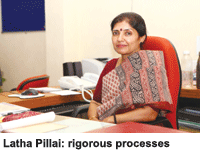 Prickly about charges that its large menu of academic programmes is susceptible to quality dilution, the IGNOU management has instituted a rigorous content development process. All course content — printed and audio-visual — is prepared by experts and committees comprising external experts as well as IGNOU faculty. “The introduction of every study programme in IGNOU is preceded by a need analysis to ascertain social, industry and academic demand. Based on this analysis a series of expert committee meetings are held to outline the curriculum and the task of writing lessons is entrusted to subject experts. A unique feature of IGNOU’s content development process is the involvement of thousands of experts who are teachers in the conventional system in addition to IGNOU faculty. Moreover special care is taken to ensure that all content is packaged into self-learning formats, which is the essence of distance learning. Given this rigorous curriculum development process, I believe IGNOU course content is on a par with, and in many disciplines better than conventional universities,” says Dr. Latha Pillai (no relation) an alumna of the University of Madras who served for several years in UGC and NAAC before being appointed pro-vice chancellor of IGNOU in 2007.
Prickly about charges that its large menu of academic programmes is susceptible to quality dilution, the IGNOU management has instituted a rigorous content development process. All course content — printed and audio-visual — is prepared by experts and committees comprising external experts as well as IGNOU faculty. “The introduction of every study programme in IGNOU is preceded by a need analysis to ascertain social, industry and academic demand. Based on this analysis a series of expert committee meetings are held to outline the curriculum and the task of writing lessons is entrusted to subject experts. A unique feature of IGNOU’s content development process is the involvement of thousands of experts who are teachers in the conventional system in addition to IGNOU faculty. Moreover special care is taken to ensure that all content is packaged into self-learning formats, which is the essence of distance learning. Given this rigorous curriculum development process, I believe IGNOU course content is on a par with, and in many disciplines better than conventional universities,” says Dr. Latha Pillai (no relation) an alumna of the University of Madras who served for several years in UGC and NAAC before being appointed pro-vice chancellor of IGNOU in 2007.
Though established as a Central university vested with the power to design its own syllabuses, curriculums and award degrees, in its early years IGNOU didn’t enjoy a high academic reputation. In the public perception its study programmes delivered through postal tuition packages were regarded as inferior to those dispensed by bricks-and-mortar colleges and universities. However in 1992, IGNOU received a status boost when the University Grants Commission officially declared its degrees/diplomas/certificates on a par with certification granted by conventional universities. Subse-quently in 1994 the Association of Indian Universities also acknow-ledged the status parity of IGNOU degrees. Moreover in 1993, IGNOU was designated the first centre of excellence for distance education worldwide by the Canada-based Commonwealth of Learning. Such national and international vali-dation of its distance education model encouraged the IGNOU management to gradually expand its academic programmes.
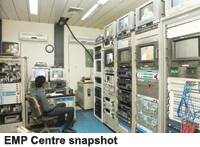 Surprisingly, despite being a government initiative, over the past two decades, IGNOU has proactively embra-ced new ICTs to supplement its print medium course material. This pioneer open varsity is credited with designing a unique hybrid ODL model which combines self-instructional print material, traditional classroom instruction, audio-video content, radio and television broadcasts, counseling/tutoring, labor-atory and hands-on experience, teleconferencing, video conferencing, interactive radio counseling, interactive multimedia CD-ROMs and internet-based learning. IGNOU’s 2.89 million students are educated through multiple media including traditional postal study materials, classroom teaching at its 61 regional and 3,000 learner support centres, audio-video content relayed on a television channel via Edusat satellite technology and lectures over the internet.
Surprisingly, despite being a government initiative, over the past two decades, IGNOU has proactively embra-ced new ICTs to supplement its print medium course material. This pioneer open varsity is credited with designing a unique hybrid ODL model which combines self-instructional print material, traditional classroom instruction, audio-video content, radio and television broadcasts, counseling/tutoring, labor-atory and hands-on experience, teleconferencing, video conferencing, interactive radio counseling, interactive multimedia CD-ROMs and internet-based learning. IGNOU’s 2.89 million students are educated through multiple media including traditional postal study materials, classroom teaching at its 61 regional and 3,000 learner support centres, audio-video content relayed on a television channel via Edusat satellite technology and lectures over the internet.
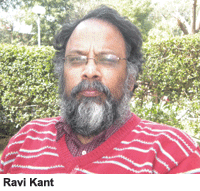 “IGNOU has revolutionised distance education in the country by taking the lead in adopting new technologies whether it’s the internet, satellite, television or radio for teaching\ learning. India’s first virtual campus was established by IGNOU and we were the first institution of higher education to offer lessons on CD-ROMs, two-way interaction via video-conferencing, student counseling over the radio, and to broadcast educational content on a television channel. Now we have added two-way interaction through internet-based protocols, and are webcasting our video programmes on the IGNOU website. This new 21st century model of interactive distance education has eliminated the deficiencies of the traditional one-way distance learning method, and enabled students around the country to conveniently access quality education at affordable prices,” says Ravi Kanth, an alumnus of Jamia Milia Islamia University, Delhi and York University, UK and incumbent director of IGNOU’s Electronic Media Production Centre (EMPC).
“IGNOU has revolutionised distance education in the country by taking the lead in adopting new technologies whether it’s the internet, satellite, television or radio for teaching\ learning. India’s first virtual campus was established by IGNOU and we were the first institution of higher education to offer lessons on CD-ROMs, two-way interaction via video-conferencing, student counseling over the radio, and to broadcast educational content on a television channel. Now we have added two-way interaction through internet-based protocols, and are webcasting our video programmes on the IGNOU website. This new 21st century model of interactive distance education has eliminated the deficiencies of the traditional one-way distance learning method, and enabled students around the country to conveniently access quality education at affordable prices,” says Ravi Kanth, an alumnus of Jamia Milia Islamia University, Delhi and York University, UK and incumbent director of IGNOU’s Electronic Media Production Centre (EMPC).
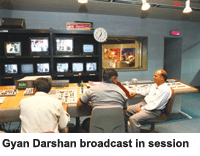 Set up in 1986 as a communication division, it evolved into a post production centre in the early 90s, and into the Electronic Media Product-ion Centre in January, 1997 with a generous grant of Rs.65 crore from the Japan International Cooperation Agency (JICA). EMPC’s state-of-the-art infras-tructure includes four audio-video studios, editing suites and teleconfer-encing facilities. Currently it has a headcount of 150 professionals, is the broadcasting hub of all IGNOU prepared content on the 24-hour television channel Gyan Darshan (a collaboration between the Union HRD ministry, Prasar Bharti and IGNOU), the radio channel Gyan Vani, and is also one of the hubs for Edusat and the HRD ministry’s National Mission for Education through ICT. Launched in January 2000, Gyan Darshan has now expanded into a bouquet of channels — GD-1, GD-2 and GD-3 Ekalavya — and broadcasts programmes of educational institutions such as IGNOU, UGC, NCERT, IITs, etc. All transmission on these channels is up-linked from EMPC’s sophisticated earth station sited on the 150-acre IGNOU campus in Delhi.
Set up in 1986 as a communication division, it evolved into a post production centre in the early 90s, and into the Electronic Media Product-ion Centre in January, 1997 with a generous grant of Rs.65 crore from the Japan International Cooperation Agency (JICA). EMPC’s state-of-the-art infras-tructure includes four audio-video studios, editing suites and teleconfer-encing facilities. Currently it has a headcount of 150 professionals, is the broadcasting hub of all IGNOU prepared content on the 24-hour television channel Gyan Darshan (a collaboration between the Union HRD ministry, Prasar Bharti and IGNOU), the radio channel Gyan Vani, and is also one of the hubs for Edusat and the HRD ministry’s National Mission for Education through ICT. Launched in January 2000, Gyan Darshan has now expanded into a bouquet of channels — GD-1, GD-2 and GD-3 Ekalavya — and broadcasts programmes of educational institutions such as IGNOU, UGC, NCERT, IITs, etc. All transmission on these channels is up-linked from EMPC’s sophisticated earth station sited on the 150-acre IGNOU campus in Delhi.
With most of its course content available in the digital form, in June 2008 IGNOU launched an exclusive internet portal — e-Gyankosh — to store, index, preserve, distribute and share the digital learning resources developed by its 21 schools of studies, with an investment of Rs.5 crore. Currently 40,000 self-instructional print materials and over 1,600 videographed lessons/lectures are available on e-Gyankosh.
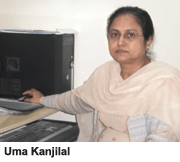 “The idea of e-Gyankosh took root when we began developing video content for Edusat. More than 95 percent of our content was already available digitally, and we had already prepared 1,600 video-based lessons which were available on YouTube. Therefore the next step was to have an internet repository — e-Gyankosh — storing all our learning resources which can be accessed by students. Moreover we wanted e-Gyankosh to be a national repository for distance education students countrywide, and hence we allowed access to other open and distance learning institutions to store and share their content. All content on this portal is available as PDF files which can be downloaded by anybody with an ordinary 100 kbps internet connection,” says Prof. Uma Kanjilal, director of IGNOU’s School of Social Sciences, which currently offers 50 courses to 20,000 students.
“The idea of e-Gyankosh took root when we began developing video content for Edusat. More than 95 percent of our content was already available digitally, and we had already prepared 1,600 video-based lessons which were available on YouTube. Therefore the next step was to have an internet repository — e-Gyankosh — storing all our learning resources which can be accessed by students. Moreover we wanted e-Gyankosh to be a national repository for distance education students countrywide, and hence we allowed access to other open and distance learning institutions to store and share their content. All content on this portal is available as PDF files which can be downloaded by anybody with an ordinary 100 kbps internet connection,” says Prof. Uma Kanjilal, director of IGNOU’s School of Social Sciences, which currently offers 50 courses to 20,000 students.
Given its leadership role in pioneering and incorporating new ICT and internet technologies in education, it’s unsurprising that IGNOU is the preferred partner of the Union HRD ministry for collaboration in the domain of ICT-enabled education. A case in point is the Sakshat e-learning portal designed and developed by IGNOU for the HRD ministry’s National Mission in Education through ICT.
While IGNOU has undoubtedly made distance education more student-friendly, acceptable and respectable by integrating new ICT and internet technologies, it has also reached out to conventional bricks-and-mortar institu-tions by offering its study programmes on their campuses. Under a unique ‘Convergence of Open and Distance Learning and Conventional Systems scheme’, launched in 2007, IGNOU offers its undergraduate, postgrad, diploma and certificate programmes to students in partner colleges and universities through the conventional as well as distance learning modes. Under the scheme, partner institutions can offer IGNOU’s undergraduate/ postgraduate programmes to new students after college hours, while students already enroled in full-time undergrad/postgrad programmes can opt for its short-term value-added certificate and diploma courses and/or pursue dual degrees. Thus far 30,000 students from 411 colleges and universities countrywide have signed up for additional IGNOU certification.
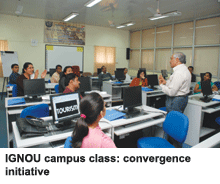 Moreover by way of a notable reverse engineering initiative, the IGNOU management has begun to offer conventional full-time programmes on its sprawling 150-acre landscaped campus in Delhi which hosts over 1,500 employees, and offers contemporary facilities including a 600-seat convention centre, well-equipped conference rooms, academic complex, a state-of-the-art modular science and computer laboratory, guest house, and housing for 400 employees.
Moreover by way of a notable reverse engineering initiative, the IGNOU management has begun to offer conventional full-time programmes on its sprawling 150-acre landscaped campus in Delhi which hosts over 1,500 employees, and offers contemporary facilities including a 600-seat convention centre, well-equipped conference rooms, academic complex, a state-of-the-art modular science and computer laboratory, guest house, and housing for 400 employees.
Currently 11 Master’s degree programmes are being offered to 218 full-time students by eight schools of study. The most promising of these is the Master’s programme in mass communi-cation offered by the School of Journalism and New Media Studies. “This postgrad programme is unique and has been specially designed in collaboration with Unesco and international communication experts. Graduates will be jointly certified by Unesco and IGNOU. We plan to roll it out across the country and Asia through the distance education mode this year. Moreover we have also introduced a programme in community radio opera-tion and management,” says Prof. Shambu Nath Singh, director of the school.
Moreover the university offers a one-of-its-kind BA in applied sign language — designed in collaboration with the University of Central Lancashire (UK) — to 30 hearing impaired students. Another notable learning programme launched by the IGNOU community of 413 teachers and distance learning professionals is Gyan Deep. Inaugurated on November 19, 2009 by President Pratibha Patil, IGNOU in collaboration with the Indian Army plans to offer two-year vocational education degrees to 50,000 soldiers who retire from the army every year.
Yet perhaps the most high-potential initiative to be launched by IGNOU in recent years is its community colleges programme. Against the backdrop of a mere 3.5 million Indian youth enroled in vocational education and training (VET) institutions (cf. 90 million in China), IGNOU’s community colleges progra-mme launched in partnership with government and private sector orga-nisations, promises to contribute in a big way towards skilling India’s 450 million low-productivity workforce. Under the scheme, partner VET institutes and community colleges offer IGNOU’s two-year associate degree programmes to students through the traditional class-room instruction model. Since its inauguration in July last year, 300 private community colleges across the country have signed up with IGNOU to offer its skills-based associate degree progra-mmes in business, office practice, accounting, agriculture, computer technologies, textile and fashion design, hospitality, tourism and para medicine to 11,000 full-time students. On completion of the two-year associate degree, students who wish to study further have the option of lateral entry into the third year of a bachelor’s degree programme with IGNOU.
.gif) Given the extraordinary role it has played in expanding higher education capacity, and particularly in facilitating the inclusion of students from lower income groups and rural India into the higher education system, it’s unsurprising that IGNOU is lauded as a role model distance education provider. Comments Dr. Darlie Koshy, former director of the National Institute of Design, Ahmed-abad and currently the Delhi-based director general (education and training) of the Apparel Export Promotion Council: “Over the past 25 years IGNOU has rendered the nation great service by expanding the reach of higher education. Its courses and content have improved substantially and are invested with considerable academic rigour, and are especially useful for knowledge upgradation and career advancement. Commendably, IGNOU has kept in step with the times and moved from generic academic qualifications to employment-oriented programmes for the banking, insurance, retail, apparel sectors. I’m hopeful that Indian industry will come forward and join with IGNOU to create a skilled and employable national workforce.”
Given the extraordinary role it has played in expanding higher education capacity, and particularly in facilitating the inclusion of students from lower income groups and rural India into the higher education system, it’s unsurprising that IGNOU is lauded as a role model distance education provider. Comments Dr. Darlie Koshy, former director of the National Institute of Design, Ahmed-abad and currently the Delhi-based director general (education and training) of the Apparel Export Promotion Council: “Over the past 25 years IGNOU has rendered the nation great service by expanding the reach of higher education. Its courses and content have improved substantially and are invested with considerable academic rigour, and are especially useful for knowledge upgradation and career advancement. Commendably, IGNOU has kept in step with the times and moved from generic academic qualifications to employment-oriented programmes for the banking, insurance, retail, apparel sectors. I’m hopeful that Indian industry will come forward and join with IGNOU to create a skilled and employable national workforce.”
.gif) Dr. Koshy’s endorsement of IGNOU, which is often subject to jibes and sneers of mainstream academics, is complemented by Anand Sudarshan, the knowledgeable Bangalore-based chief executive of Manipal Education Group — India’s premier provider of professional education which manages 55 institutions of higher learning in India and abroad. “It’s important to bear in mind that by academic norms IGNOU at 25 is a young institution. In a relatively short span of time it has established itself as perhaps the world’s largest provider of a wide range of non-formal degree and skills development progra-mmes to almost 3 million students from hitherto neglected sections of society. That’s a tremendous achievement. In particular during the past two-three years IGNOU has rendered great service to Indian education by introducing the concept of community colleges and signing up a large number of innovative partnerships and collaborations,” says Sudarshan.
Dr. Koshy’s endorsement of IGNOU, which is often subject to jibes and sneers of mainstream academics, is complemented by Anand Sudarshan, the knowledgeable Bangalore-based chief executive of Manipal Education Group — India’s premier provider of professional education which manages 55 institutions of higher learning in India and abroad. “It’s important to bear in mind that by academic norms IGNOU at 25 is a young institution. In a relatively short span of time it has established itself as perhaps the world’s largest provider of a wide range of non-formal degree and skills development progra-mmes to almost 3 million students from hitherto neglected sections of society. That’s a tremendous achievement. In particular during the past two-three years IGNOU has rendered great service to Indian education by introducing the concept of community colleges and signing up a large number of innovative partnerships and collaborations,” says Sudarshan.
Nevertheless although IGNOU has expanded higher education capacity and democratised it, in the public mind there’s still a persistent doubt about the quality and general acceptability of IGNOU certification. It’s an open secret that most employers tend to prefer conventional over distance education graduates. “There is a question mark over the quality of distance education delivered by IGNOU. The concern in Indian industry is about the quality of students enroling, quality of curriculum and mode of delivery and therefore the final product. Definitely, in the job market, distance education graduates are less valued,” says Anjan Das, senior director (education) at the Confe-deration of Indian Industry (CII) headquarters in Delhi.
The relatively lower standing of IGNOU graduates and diploma holders in the job market is obviously the outcome of its policy of inclusiveness. Whereas all reputed colleges and institutions of higher education stipulate high secondary and higher secondary cut-off percentages for admission, to fulfill its mandate of inclusive education, IGNOU admits students with minimal pass percentages. Therefore there’s an inherent trade-off between its second chance and inclu-sive education goals, and the uneven quality of the average IGNOU alumnus.
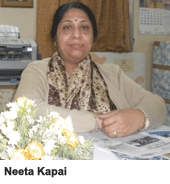 Meanwhile IGNOU’s placement cell established in 2006, is working overtime to educate public opinion and improve public acceptance of distance education graduates, with a track record of having placed several thousand graduates in retail, tourism, hospitality and BPO industries. “We regularly interact with the human resource departments of companies and also convene learners’ conferences to discuss employers’ concerns. Recently on our website we have introduced a resumé database service where companies can access IGNOU graduates free of charge,” says Dr. Neeta Kapai, director of the campus placement cell.
Meanwhile IGNOU’s placement cell established in 2006, is working overtime to educate public opinion and improve public acceptance of distance education graduates, with a track record of having placed several thousand graduates in retail, tourism, hospitality and BPO industries. “We regularly interact with the human resource departments of companies and also convene learners’ conferences to discuss employers’ concerns. Recently on our website we have introduced a resumé database service where companies can access IGNOU graduates free of charge,” says Dr. Neeta Kapai, director of the campus placement cell.
Yet if 25 years on, despite its many innovations and major contributions to expansion of higher and vocational education IGNOU has not fired the national imagination, this is mainly because of its historical legacy as a government institution firmly tied to the apron strings of the Union HRD ministry. And typically, given the socialist mindset of govern-ment bureaucrats and academics, minimal attention was accorded to marketing, promoting and building the IGNOU brand. For instance in fiscal 2009-10, a mere Rs.5 crore, equivalent to one percent of revenue, was spent on advertising, sales promotion and brand building. And even this modest outlay for advertising is five times higher than it was until the new management under Dr. Raja-sekharan Pillai took charge and metamorphosed IGNOU.
Moreover with this pioneer distance education institution’s income from students’ fees aggregating only Rs.266 crore (in fiscal 2008-09) against its annual expenditure of Rs.494 crore, IGNOU is critically dependent upon the annual grant of Rs.80-100 crore it receives from the Central government. Hence room to exercise financial or administrative autonomy is limited, and the IGNOU management is obliged to fall in line with the heavily subsidised tuition fees and faculty remuneration norms of Central universities.
Therefore 25 years after IGNOU registered its first distance learning students, its management has taken fresh guard and is set to build a second innings. For one, it has actively engaged itself with the objectives of increasing the percentage of youth in higher education from the current 12 percent to 15 percent by the year 2015, and skilling India’s low-productivity workforce. The incumbent management of IGNOU believes that by partnering with bricks-and-mortar universities and harnessing the power of ICT technologies, IGNOU can play a major role in expanding access to higher education and popularising vocational education and training.
“IGNOU has prepared a detailed 10-year action plan with three focus areas — skills development, gross enrolment ratio (GER) enhancement and teacher training. In the area of skills develop-ment, IGNOU has already begun networking and collaborating with public and private education institutions to provide skills-oriented training. Our target is to train 1 million school and college drop-outs every year by providing them VET through PPP (public-private partnership) institutions. To enhance GER in higher education by 1 percent per year, we are working on convergence of the conventional system with technology-enabled ODL models. And in the area of teacher education, we will be utilising ODL models including satellite technologies to train and retrain 200,000 teachers every year. IGNOU is strongly committed to harnessing the power of technology and the resources available in the formal sector to deliver high-quality distance education to those who cannot access conventional higher educ-ation,” reaffirms Dr. Rajasekharan Pillai.
Of the 200 million children enroled in the country’s 1.25 million primary schools, only 39 million complete secon-dary school and a mere 11 million enter higher education institutions. Moreover only 5 percent of 21st century India’s 450 million low-productivity workforce has received formal vocational education. These dismal statistics could drama-tically change for the better if IGNOU comes of age and replicates itself in state capitals across the country.